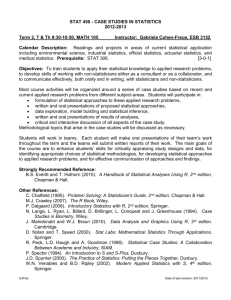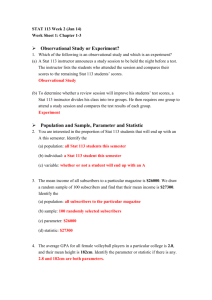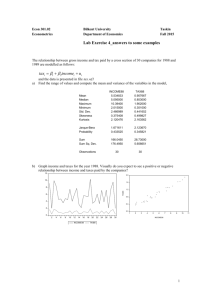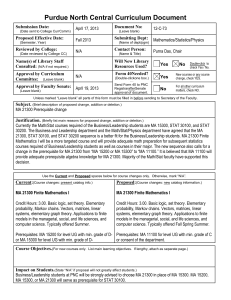New Mexico - Columbia Law School
advertisement
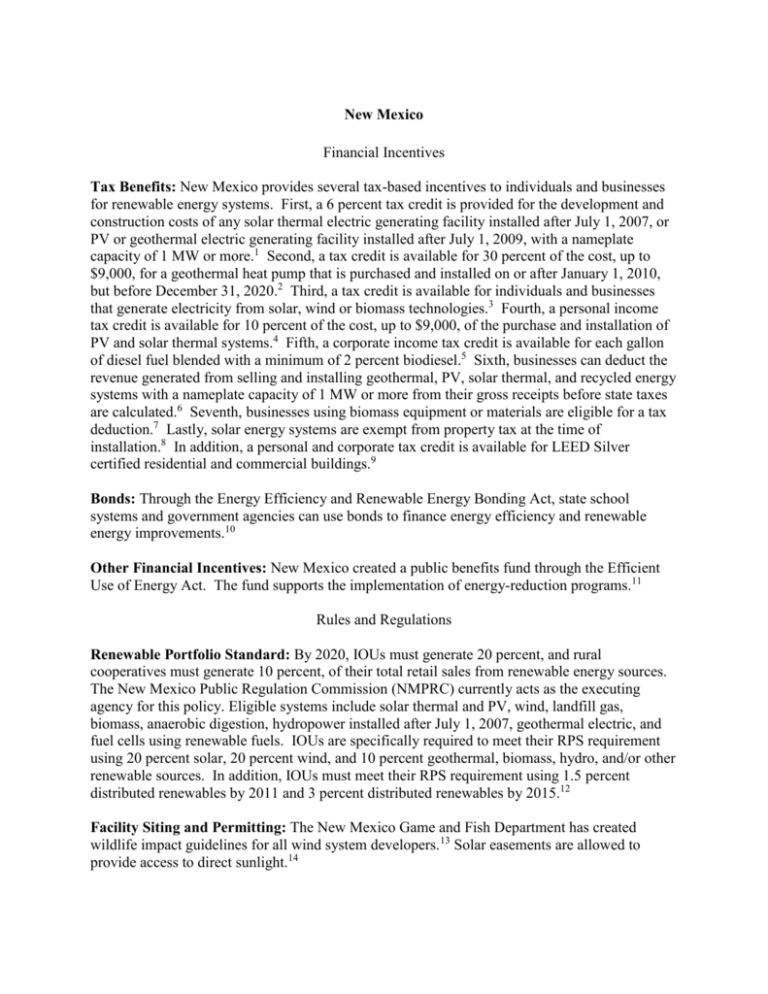
New Mexico Financial Incentives Tax Benefits: New Mexico provides several tax-based incentives to individuals and businesses for renewable energy systems. First, a 6 percent tax credit is provided for the development and construction costs of any solar thermal electric generating facility installed after July 1, 2007, or PV or geothermal electric generating facility installed after July 1, 2009, with a nameplate capacity of 1 MW or more.1 Second, a tax credit is available for 30 percent of the cost, up to $9,000, for a geothermal heat pump that is purchased and installed on or after January 1, 2010, but before December 31, 2020.2 Third, a tax credit is available for individuals and businesses that generate electricity from solar, wind or biomass technologies.3 Fourth, a personal income tax credit is available for 10 percent of the cost, up to $9,000, of the purchase and installation of PV and solar thermal systems.4 Fifth, a corporate income tax credit is available for each gallon of diesel fuel blended with a minimum of 2 percent biodiesel.5 Sixth, businesses can deduct the revenue generated from selling and installing geothermal, PV, solar thermal, and recycled energy systems with a nameplate capacity of 1 MW or more from their gross receipts before state taxes are calculated.6 Seventh, businesses using biomass equipment or materials are eligible for a tax deduction.7 Lastly, solar energy systems are exempt from property tax at the time of installation.8 In addition, a personal and corporate tax credit is available for LEED Silver certified residential and commercial buildings.9 Bonds: Through the Energy Efficiency and Renewable Energy Bonding Act, state school systems and government agencies can use bonds to finance energy efficiency and renewable energy improvements.10 Other Financial Incentives: New Mexico created a public benefits fund through the Efficient Use of Energy Act. The fund supports the implementation of energy-reduction programs.11 Rules and Regulations Renewable Portfolio Standard: By 2020, IOUs must generate 20 percent, and rural cooperatives must generate 10 percent, of their total retail sales from renewable energy sources. The New Mexico Public Regulation Commission (NMPRC) currently acts as the executing agency for this policy. Eligible systems include solar thermal and PV, wind, landfill gas, biomass, anaerobic digestion, hydropower installed after July 1, 2007, geothermal electric, and fuel cells using renewable fuels. IOUs are specifically required to meet their RPS requirement using 20 percent solar, 20 percent wind, and 10 percent geothermal, biomass, hydro, and/or other renewable sources. In addition, IOUs must meet their RPS requirement using 1.5 percent distributed renewables by 2011 and 3 percent distributed renewables by 2015.12 Facility Siting and Permitting: The New Mexico Game and Fish Department has created wildlife impact guidelines for all wind system developers.13 Solar easements are allowed to provide access to direct sunlight.14 Building Codes, Appliance, and Equipment Standards: The 2009 New Mexico Energy Conservation Code (NMECC) became effective on January 28, 2011. The NMECC adopts the 2009 IECC for residential and commercial buildings.15 New construction of public buildings over 15,000 square feet or using over 50 kW peak electrical demand and renovations involving the replacement of more than three major systems must achieve the LEED Silver rating. Smaller state building projects are subject to less stringent energy efficiency standards.16 Electricity Transmission, Interconnection and Storage: IOUs and electric cooperatives are required to offer net metering to all renewable energy and CHP systems generating up to 80 MW. NMPRC oversees this policy.17 NMPRC likewise oversees the state’s interconnection policy, which provides a four-tiered approach based upon kW production. In general, systems up to 10 kW in capacity are eligible for the simplified interconnection process.18 IOUs are required to offer a voluntary green power program to customers. Rural electric cooperatives are also required to offer a voluntary green power program to customers, but only to the extent that their energy suppliers make such renewable resources available.19 Government Procurement: All state agencies must reduce energy consumption 20 percent by 2015, compared to 2005.20 All diesel fuel used by state agencies and public schools must contain at least 5 percent biodiesel.21 Policies, Plans, and Governmental Affiliations Policies and Plans: New Mexico has set a target of reducing statewide GHG emissions to 2000 levels by 2012, 10 percent below 2000 levels by 2020, and 75 percent below 2000 levels by 2050.22 New Mexico also has a goal of a 10 percent reduction in per capita energy use statewide from 2005 levels by 2012 and a 20 percent reduction from 2005 levels by 2020.23 Under the Green Jobs Act, the New Mexico Higher Education Department must implement a program providing green job training to interested individuals by December 31, 2010.24 Government Entities: New Mexico Energy, Minerals and Natural Resources Department,25 New Mexico Environment Department,26 New Mexico Public Regulation Commission,27 New Mexico Game and Fish Department.28 Regional Memberships: New Mexico is a member of the WGA, ICAP, and WCI. 1 N.M. Stat. § 7-2-18.25; N.M. Stat. § 7-2A-25. HB 375 (2009); http://www.emnrd.state.nm.us/ECMD/RenewableEnergy/geothermal.htm. 3 N.M. Stat. § 7-2-18.18; N.M. Stat. § 7-2A-19. 4 N.M. Stat. § 7-2-18.14; N.M. Admin. Code 3.3.28; http://www.emnrd.state.nm.us/ECMD/CleanEnergyTaxIncentives/solartaxcredit.htm. 5 N.M. Stat. § 7-2A-23. 6 N.M. Stat. § 7-9-114. 7 N.M. Stat. § 7-9-98. 8 N.M. Stat. § 7-36-21.2. 9 N.M. Stat. § 7-2-18.19; N.M. Stat. § 7-2A-21; http://www.emnrd.state.nm.us/ecmd/cleanenergytaxincentives/sustainablebuildingtaxcredit.htm. 10 N.M. Stat. § 6-21D-1 et seq.; http://www.nmfa.net/NMFAInternet/NMFA_Web.aspx?ContentID=13. 11 N.M. Stat. § 62-17-1 et seq. 2 12 N.M. Stat. § 62-16-1 et seq.; N.M. Stat. § 62-15-34 et seq.; N.M. Admin. Code 17.9.572; http://www.nmprc.state.nm.us/renewable.htm. 13 http://www.wildlife.state.nm.us/conservation/habitat_handbook/documents/WindEnergyGuidelines.htm. 14 N.M. Stat. § 47-3-1 et seq. 15 N.M. Admin. Code 14.7.6. 16 Executive Order 2006-001. 17 N.M. Admin. Code 17.9.570. 18 N.M. Admin. Code 17.9.568; N.M. Admin Code 17.9.569; The New Mexico Interconnection Manual. 19 N.M. Admin. Code 17.9.572; http://www.nmprc.state.nm.us/renewable.htm. 20 Executive Order 2007-053. 21 N.M. Stat. § 57-19-29. 22 Executive Order 2005-033. 23 Executive Order 2007-053. 24 N.M. Stat. § 9-15D-1 et seq. 25 http://www.emnrd.state.nm.us/. 26 http://www.nmenv.state.nm.us/. 27 http://www.nmprc.state.nm.us/. 28 http://www.wildlife.state.nm.us/.


